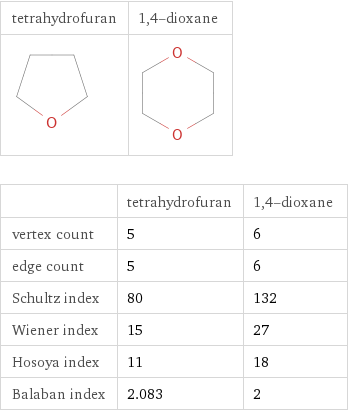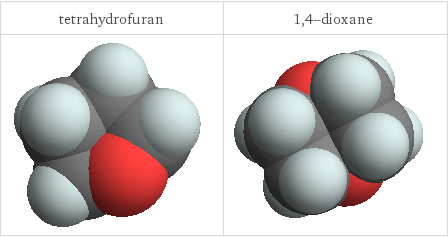Input interpretation

tetrahydrofuran | 1, 4-dioxane
Chemical names and formulas

| tetrahydrofuran | 1, 4-dioxane formula | C_4H_8O | C_4H_8O_2 Hill formula | C_4H_8O | C_4H_8O_2 name | tetrahydrofuran | 1, 4-dioxane IUPAC name | tetrahydrofuran | 1, 4-dioxane alternate names | cyclotetramethylene oxide | diethylene oxide | furanidine | furan, tetrahydro- | hydrofuran | oxacyclopentane | oxolane | tetramethylene oxide | 1, 4-diethylene dioxide | diethylene dioxide | diethylene ether | diethylene oxide | dioxane mass fractions | C (carbon) 66.6% | H (hydrogen) 11.2% | O (oxygen) 22.2% | C (carbon) 54.5% | H (hydrogen) 9.15% | O (oxygen) 36.3%
Structure diagrams

| tetrahydrofuran | 1, 4-dioxane vertex count | 5 | 6 edge count | 5 | 6 Schultz index | 80 | 132 Wiener index | 15 | 27 Hosoya index | 11 | 18 Balaban index | 2.083 | 2
3D structure

3D structure
Basic properties

| tetrahydrofuran | 1, 4-dioxane molar mass | 72.11 g/mol | 88.11 g/mol phase | liquid (at STP) | liquid (at STP) melting point | -108 °C | 11 °C boiling point | 66 °C | 101 °C density | 0.889 g/cm^3 | 1.034 g/cm^3 solubility in water | miscible | soluble dielectric constant | 7.58 | 2.209
Hydrophobicity and permeability properties

| tetrahydrofuran | 1, 4-dioxane experimental LogP hydrophobicity | -2.7 | predicted LogP hydrophobicity | -0.96 | -0.22 predicted LogS | -3.22 | 0.51